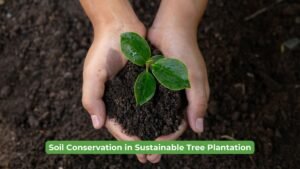If you expect trees to grow effectively and provide optimum benefits, more than planting trees is needed; you must take good care of them. Being living things, trees also require nutrients and water for their growth and survival.
In addition, trees have other necessities besides nutrition, such as pruning and shaping. Those who are planting trees and maintaining them for a very long time might be aware of these techniques and their significance.
However, those new to this tree planting and maintenance activities can go through this article to know more.
Tree Health
Although trees can live for a long time, they eventually die, either killed by humans or for foul reasons. We can diagnose the ill health of trees and prevent the spread with early treatment, pruning, or felling, thus saving timber stocks and amenity trees. However, hazardous trees can cause tremendous risks to other trees, and arborists or tree owners should be aware of this risk. Sometimes, construction projects can avoidably damage trees.
Proper tree health involves monitoring and using preventive treatments to ensure your trees stay healthy. Early leaf drops, dead branches, and discolored leaves indicate the need to contact an arborist. All trees and shrubs in a landscape share a common resource – soil. Any treatment applied to one of the trees may affect the other. Thus the care for one tree may affect the health of other trees in that landscape.

Tree Care and Tree Maintenance
Maintaining good tree health is essential after planting them till they complete their life cycle. For this purpose, we must understand tree care and maintenance concepts. So first, consider the aspects and things involved in tree care and maintenance.
Tree care involves routine monitoring, preventive treatment, and a strong working relationship between the tree owner and arborist. In addition, insects and diseases often threaten tree health; hence, you should carefully examine your trees frequently.
Mulching is another practice beneficial for better tree health. Proper mulching reduces soil moisture loss through evaporation and insulates the soil by protecting roots from extreme winter and summer temperatures. However, misapplication of mulching may harm the trees. Tree trimming, Tree shaping, and Tree pruning are other activities in tree maintenance. Although many people need clarification about these three activities, they are different from each other. So let’s look at these concepts to understand the difference between them.
Tree Trimming
Trimming refers to removing excess branches to maintain regularity in size and shape and having an aesthetically pleasing look; trimming a plant results in thicker and faster growth of the remaining foliage than if the plant were left untrimmed. Trimming is most commonly used to maintain a tree’s or shrub’s overall size. For instance, some homeowners use hedge shears to keep their foundation plantings at the desired height of 1 meter tall.
Trimming also helps reduce the crowding of plants being planted too closely together. How fast a tree grows and the weather conditions it is growing determines how frequently you should opt for trimming. Generally, deciduous trees such as oak, elm, maple, and others will require more frequent trimming than evergreens as they grow much more quickly.
Tree Shaping
Shaping is another activity in tree maintenance that can be confused with trimming and pruning. Instead, it focuses on turning your trees into aesthetically pleasing designs.
When it comes to tree shaping, you should contact a professional rather than attempt it yourself. Experts who know how the tree will grow, how weather and other factors can affect it, and how to maintain it as healthy as possible can provide you with the best tree-shaping results.
Tree shaping can be a great option for attracting people. You can also make your residential or commercial property stand out by opting for tree shaping. Overgrown, uncared-for trees cannot provide the most attractive look.
Tree Pruning
Pruning is the process that removes dead, damaged, or diseased branches. It can also involve shaping and thinning out the plant. Pruning enhances the overall health, appearance, and strength of trees or shrubs. It establishes a strong structure for tree growth while allowing them to thrive. However, trees can appear unsightly when not pruned and may become more susceptible to disease, with their size often restricted. Pruning also enhances the sunlight reaching lower branches and promotes branching and fruit production.
Compared to trimming, pruning is done less frequently since it’s usually required to be done once every two or three years. Ornamental trees and shrubs are more commonly pruned than fruit or shade trees.
You can decide on the frequency based on what you’re trying to achieve. What kind of tree it is and how fast it grows is also important. Most deciduous trees need to be pruned every two or three years. Since evergreens have less growth, they are not usually pruned as often. However, if they have dead or dying branches, it may be essential to prune them more often.
Pruning is not restricted to tree maintenance. Along with removing unnecessary branches, the term is sometimes associated with roots. If these roots and branches are dead, they must be removed. In addition, some trees. Some trees grow in the wrong direction toward electrical utility wires or structures. You can keep unwanted growth in check with pruning.

Pruning Benefits
Trees get benefit from pruning in the following ways –
Health: Tree pruning helps prevent the spread of decay and maintains a tree’s health. It also encourages the growth of healthy, new leaves and branches.
Appearance: With proper maintenance, pruning helps improve a tree’s appearance. It removes hanging, overgrown branches that appear unsightly.
Sunlight: Tree pruning enables adjacent plants to receive adequate sunlight. Overgrown branches make this region unfit for planting by shading the area directly beneath them.
Reduced Risks: Tree pruning makes the surrounding area safer by reducing the chances of accidents. Removal of hanging branches reduces the threat to buildings just beneath them.
Shape: Tree pruning helps shape young trees, resulting in good branch structure while compensating for root loss.
Pruning Tools
Choosing the right tools for pruning is equally important for the good health of trees. These tools include –
Hand Pruners: These small, lightweight, and sharp pruners make precision cuts.
Loppers: These are used to deal with branches having diameters greater than about ¼ inch.
Pruning Saws: They have curved blades and sharp teeth, good for making clean cuts.
Hedge Shears: Traditional hedge shears are good for shaping evergreen hedges and topiary.
Hedge Trimmers: These quick and efficient motorized hedge trimmers are much better than traditional shears.
Remember, choosing the right tools is not enough; don’t forget to keep them clean.
Pruning Techniques
The following pruning techniques are used depending on the objective and motivating factors –
Thinning
In this procedure, a branch is removed from its point of origin. This process can promote light penetration and manage growth.
Topping
It is a drastic process that removes most of the tree’s branches down to the trunk. It’s commonly used while training young trees to grow in certain ways.
Raising
It refers to trimming low-hanging branches and creating headroom for parked cars, pedestrians, or entryways.
Reduction
Trimming back a tree’s volume, particularly for safety reasons (for example – creating space for power lines), is called reduction.

Pruning Tips
Here, we are providing some general pruning tips for you –
- Remove branches that are broken, dead, diseased, and downward-growing.
- Remove one of the two crossed, entangled, or otherwise competing limbs at its base.
- Begin with removing large limbs from the top of the tree.
- Remove water sprouts and suckers coming up from the roots.
- Remove limbs that are bigger in diameter than the trunk.
- While making pruning cuts, ensure they are at the base of the limb, close to the branch collar.
Pruning for Tree Health
Pruning for tree health focuses on removing diseased, dead, and dying branches, along with branches that rub together, so the entire tree grows healthily. Water sprouts and suckers weaken wood at the ground level and grab nutrients from the main tree. By supporting a tree to establish one main tree along with a dominant leader, you can create a strong tree capable of withstanding high winds and winter storms.
Appearance pruning and landscape maintenance club together to create the ideal plant you envision. Trimming and pruning trees in particular ways promote flowering, and fruiting, shaping plants into specific forms and controlling their size.
If you’re interested in plants and their welfare, you can join us at Nelda Foundation to contribute to making the earth greener and better!




